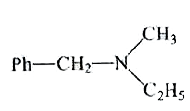Consider the following sequence of reactions :
HO−O∣∣C−CH3∣C∣CH3−C≡N200∘C−−−→ALiAIH4−−−−−−→H2OB, (B) is


HO−H2C−CH3∣C∣CH3−CH2−NH2

The correct Answer is:D
To solve the given sequence of reactions, we will break down the steps systematically.
Step 1: Identify the starting compound
The starting compound is given as:
HO - C(=O) - C(CH_3)(CH_3) - C
This can be interpreted as a carboxylic acid derivative, specifically a carboxylic acid with two methyl groups attached to the central carbon.
Step 2: Heating the compound
When this compound is heated at 200°C, the reaction leads to the formation of a nitrile. The heating causes the elimination of water and the formation of a carbon-nitrogen triple bond (nitrile). The product after this step (let's call it A) can be represented as:
C(CH_3)(CH_3) - C≡N
This indicates that the compound now has a nitrile functional group.
Step 3: Reduction using Lithium Aluminium Hydride (LiAlH4)
Next, we treat the nitrile (A) with lithium aluminium hydride (LiAlH4) followed by hydrolysis (addition of water). The nitrile group will undergo reduction to form a primary amine. The reaction can be summarized as:
R - C≡N+LiAlH4+H2O→R - CH2NH2
Where R represents the carbon chain from the original compound.
Step 4: Final structure of product B
The final product (B) will have the structure:
C(CH_3)(CH_3) - CH2NH2
This indicates that the nitrile has been reduced to a primary amine, specifically an aminoalkane.
Conclusion
Thus, the final product B is:
C(CH_3)(CH_3) - CH2NH2
This can also be represented as:
(CH3)2C−CH2NH2
The starting compound is given as:
HO - C(=O) - C(CH_3)(CH_3) - C
This can be interpreted as a carboxylic acid derivative, specifically a carboxylic acid with two methyl groups attached to the central carbon.
When this compound is heated at 200°C, the reaction leads to the formation of a nitrile. The heating causes the elimination of water and the formation of a carbon-nitrogen triple bond (nitrile). The product after this step (let's call it A) can be represented as:
C(CH_3)(CH_3) - C≡N
This indicates that the compound now has a nitrile functional group.
Next, we treat the nitrile (A) with lithium aluminium hydride (LiAlH4) followed by hydrolysis (addition of water). The nitrile group will undergo reduction to form a primary amine. The reaction can be summarized as:
R - C≡N+LiAlH4+H2O→R - CH2NH2
Where R represents the carbon chain from the original compound.
The final product (B) will have the structure:
C(CH_3)(CH_3) - CH2NH2
This indicates that the nitrile has been reduced to a primary amine, specifically an aminoalkane.
Thus, the final product B is:
C(CH_3)(CH_3) - CH2NH2
This can also be represented as:
(CH3)2C−CH2NH2
Similar Questions
Complete the following reactions:
(i) CH3−CH3∣C∣Cl−CH2CH3alcKOH−−−−→ΔAO3−−−−−→Zn/H2O(B+C)
(ii) CH3ICH−CH3alcKCN−−−−→A(i)SnCl2/HCl−−−−−−−−−−−−→(ii)H2O.OH.H2O2B
(iii) HCNHCl/AlCl3−−−−−−→A(i)C6H6Δ−−−−−−−−−−→(ii)(H2O)/H−B
(iv)
View SolutionWrite the IUPAC name of the following compound:
CH3−O∣∣C−CH3∣CH−Cl∣C∣C2H5−CH3∣CH−NO2∣CH−CH∣C2H5−CH3
View Solution
Knowledge Check
Consider the following sequence of reactions
CH3−O∣∣C−CH3Ba(OH)2−−−−−→AΔ−−→B↓NaBH4
The final product (C) is:A(CH3)2C(OH)CH2COCH3B(CH3)2C=CHCOCH3C(CH3)2CHCH2CHOHCH3D(CH3)2C=CHCHOHCH3CH3−CH3∣C∣CH3H+H2C=CH2HF−−−→2.5∘C (A) , (A) is :
A B
B C
C DCH3−CH∣CH3−CH2−CH=CH2
DCH3−CH∣CH3−CH2−CH=CH2The end product (B) of the reaction sequence :
C2H5−N−CH3Ph−O∣∣C−CI−−−−−−−→NaOHALiAIH4−−−−−−→H2OBA B
B C
C D
D
In the following reaction sequence,
CH3−C∣OH(X)H−CH3[O]−−→YCH3MgBr−−−−−−−−→H+/H2OZ
Z is
View SolutionThe IUPAC name ofCH3−OH∣C∣H−CH2−O∣∣C−CH3 is
View SolutionThe IUPAC name of CH3−O∣∣C−C∣C2H5H−C∣CH3H−CH3 is
View SolutionCH3−CH2−O∣∣C−CH3∣C∣CH3−CH3PhCO3H−−−−−→A,A will be
View SolutionH3C−CH2−CH3∣CH−C∣∣O−NH2Br2+KOH−−−−−−−−−→ΔA1.CH3I(excess)−−−−−−−−−−−−→2.AgOH,ΔB
The major product (B) is :
View Solution
